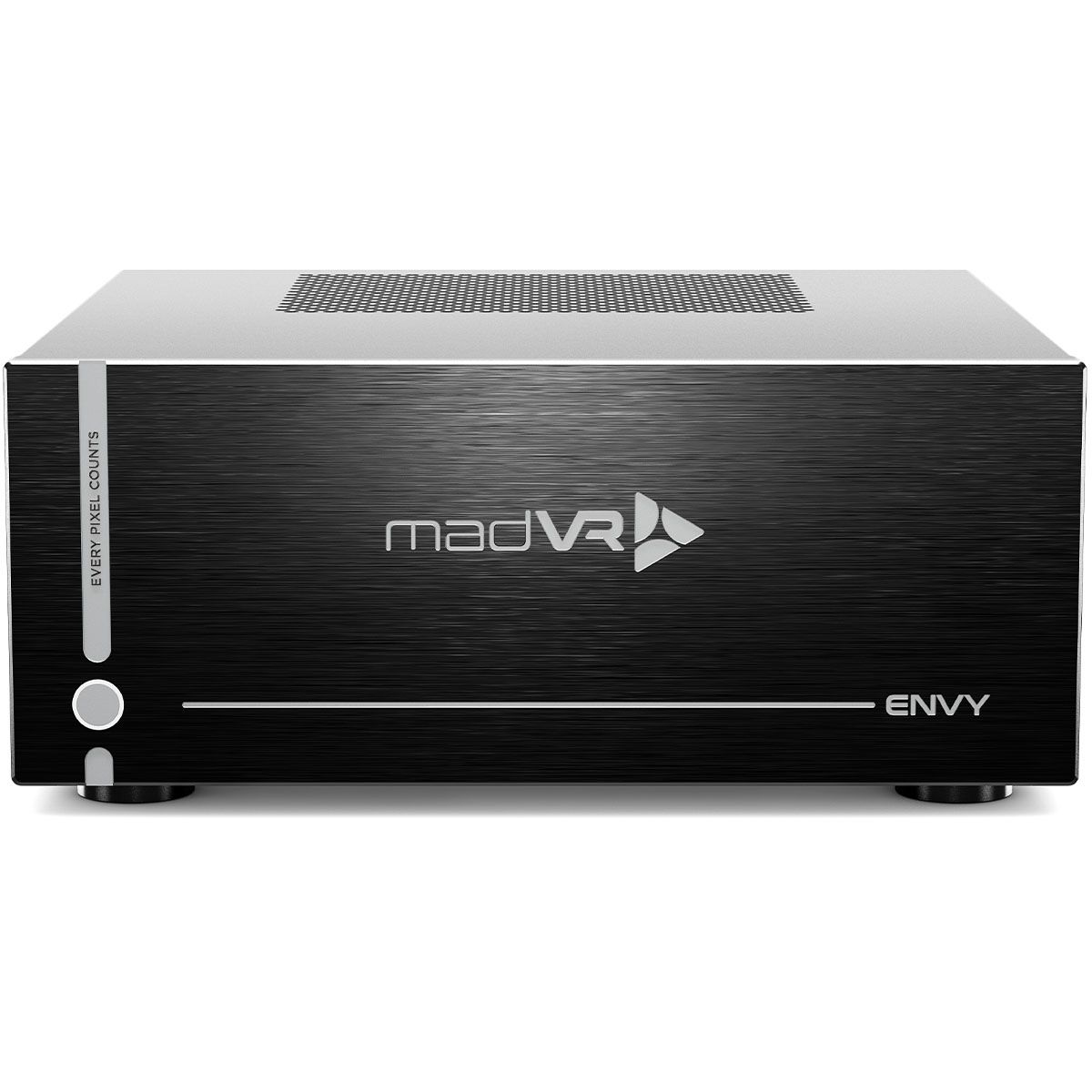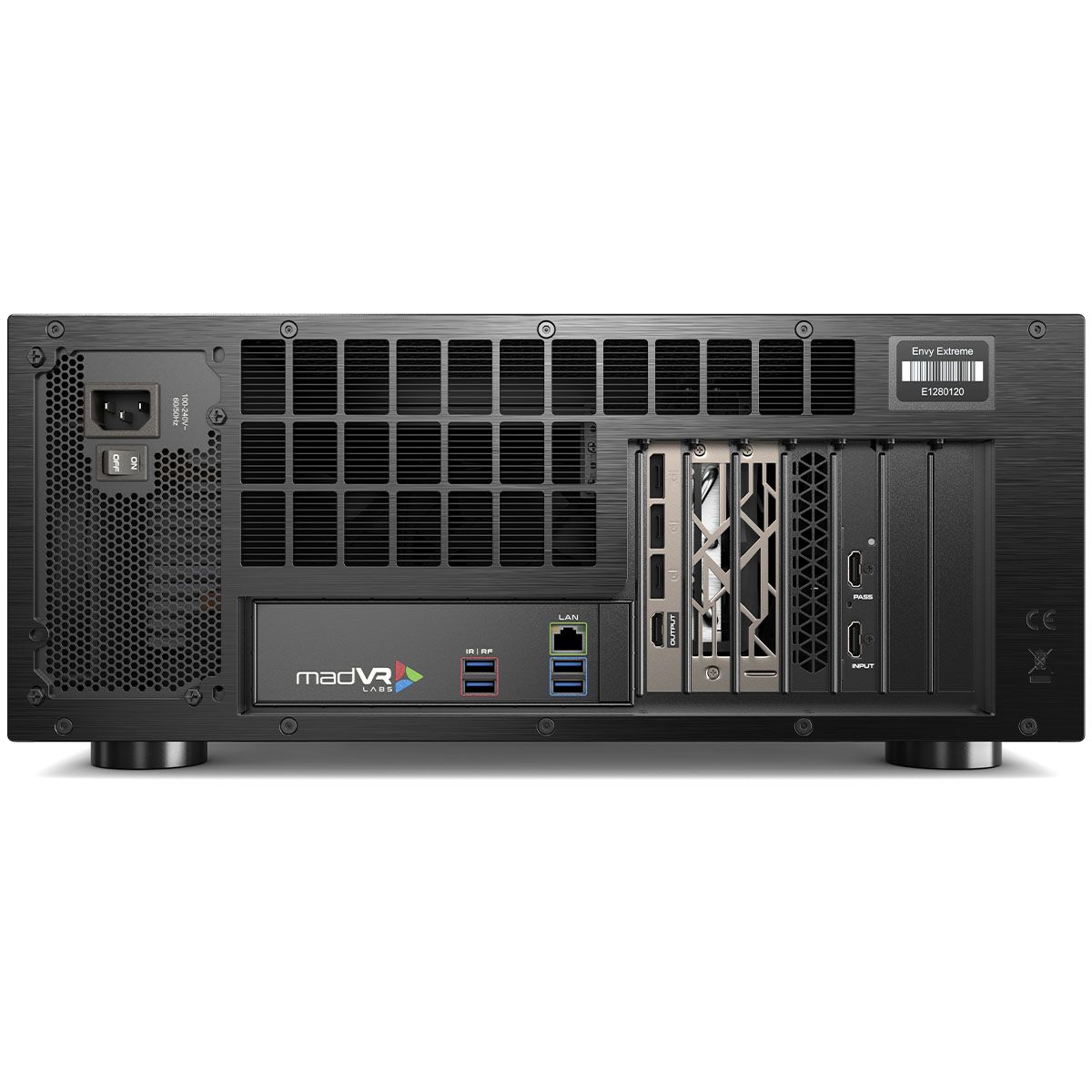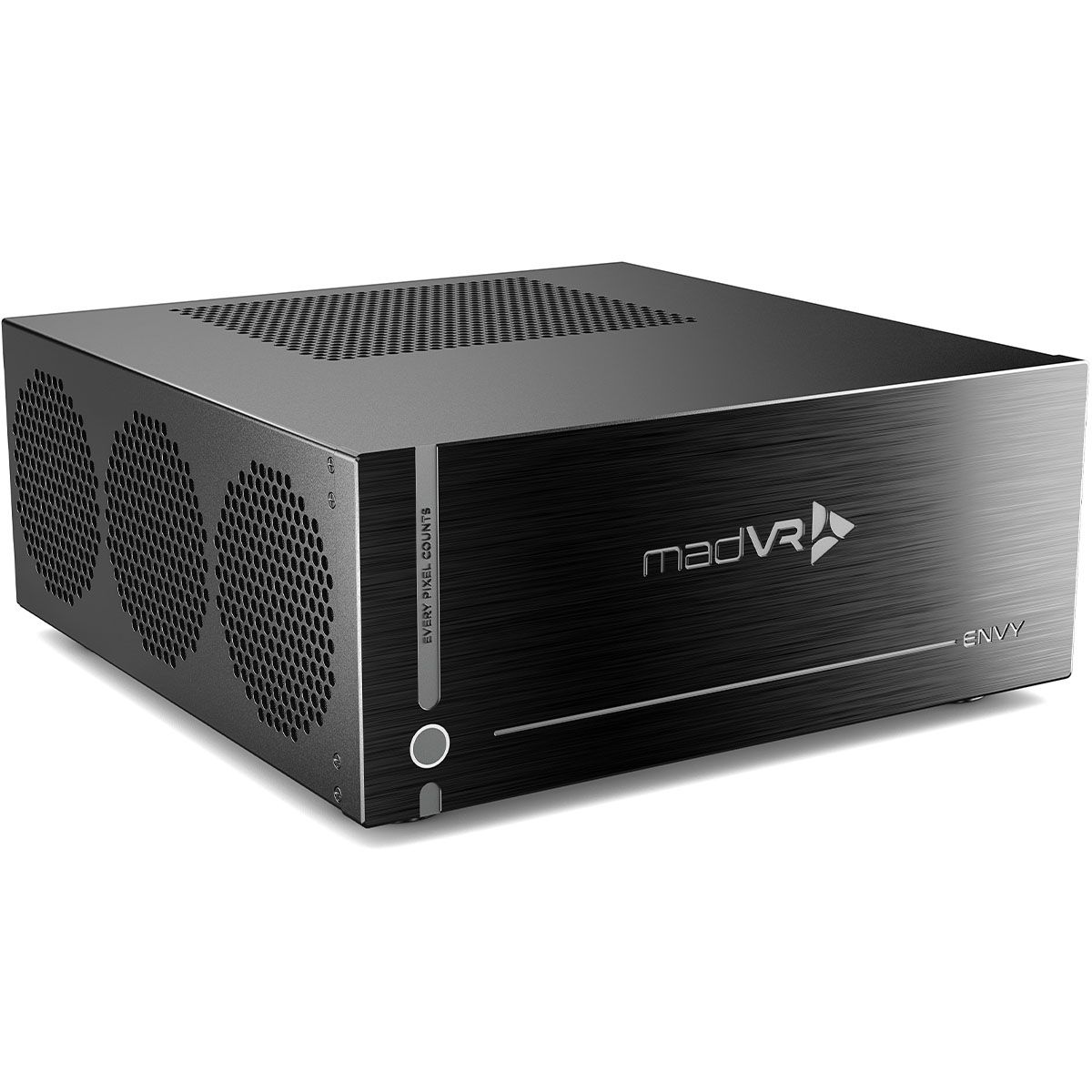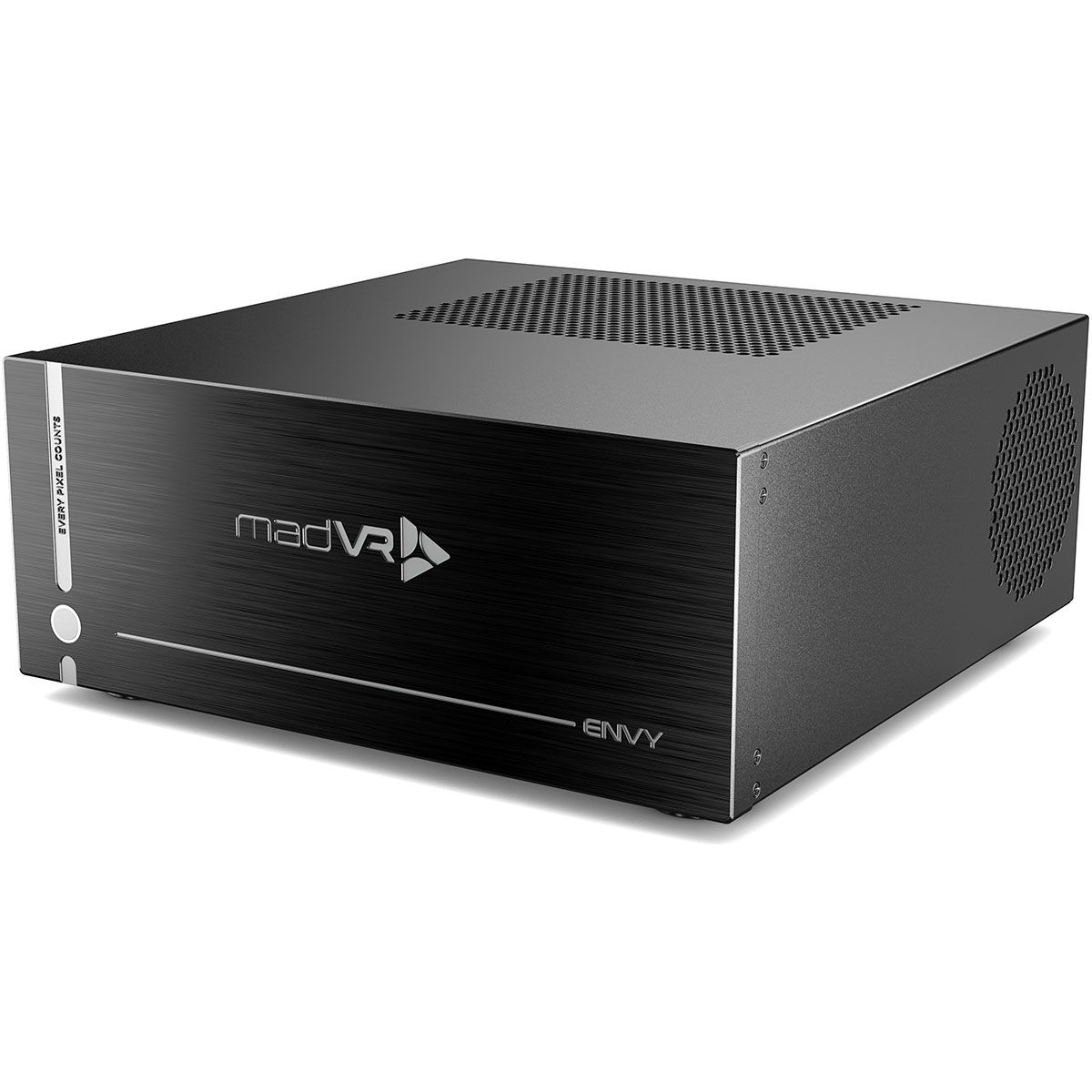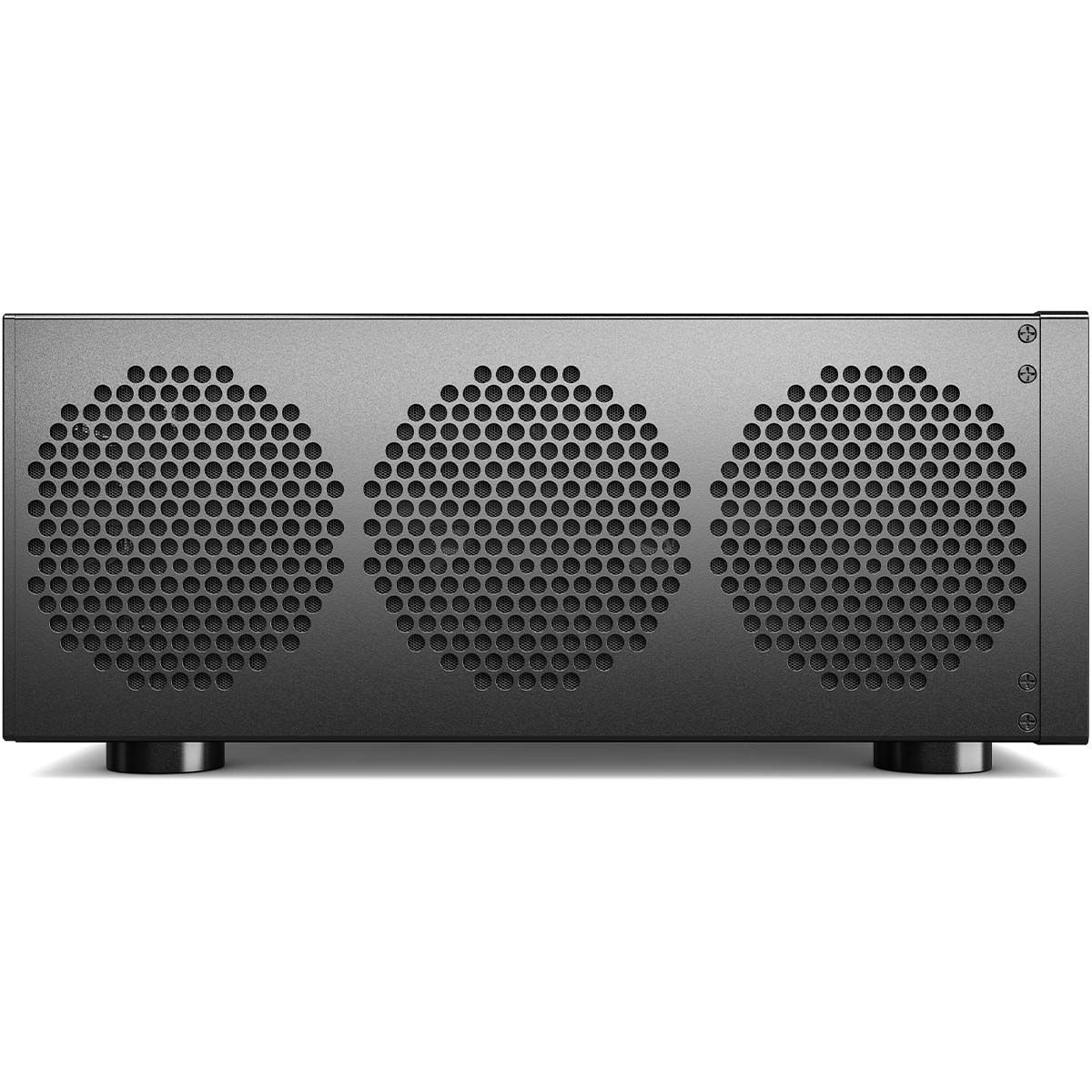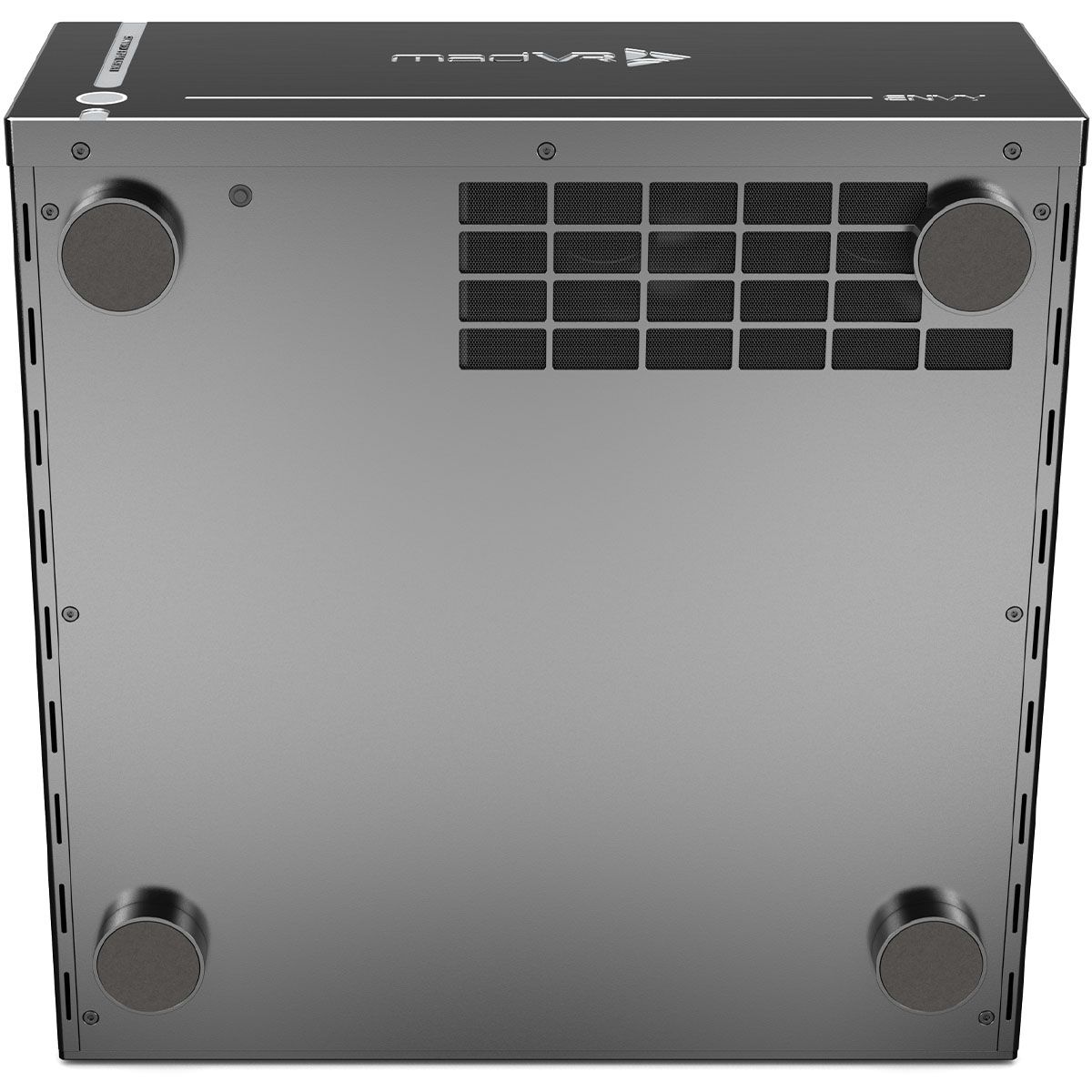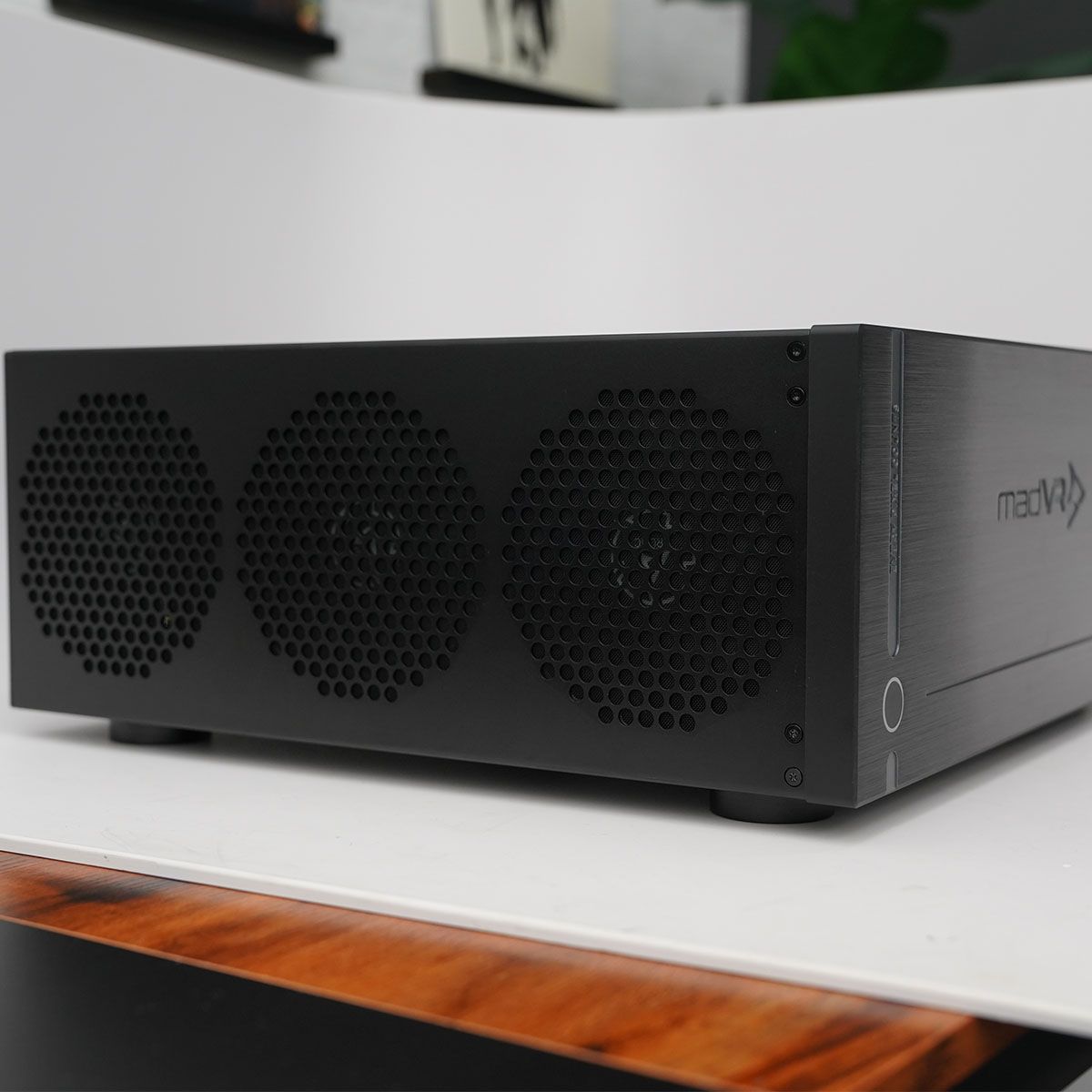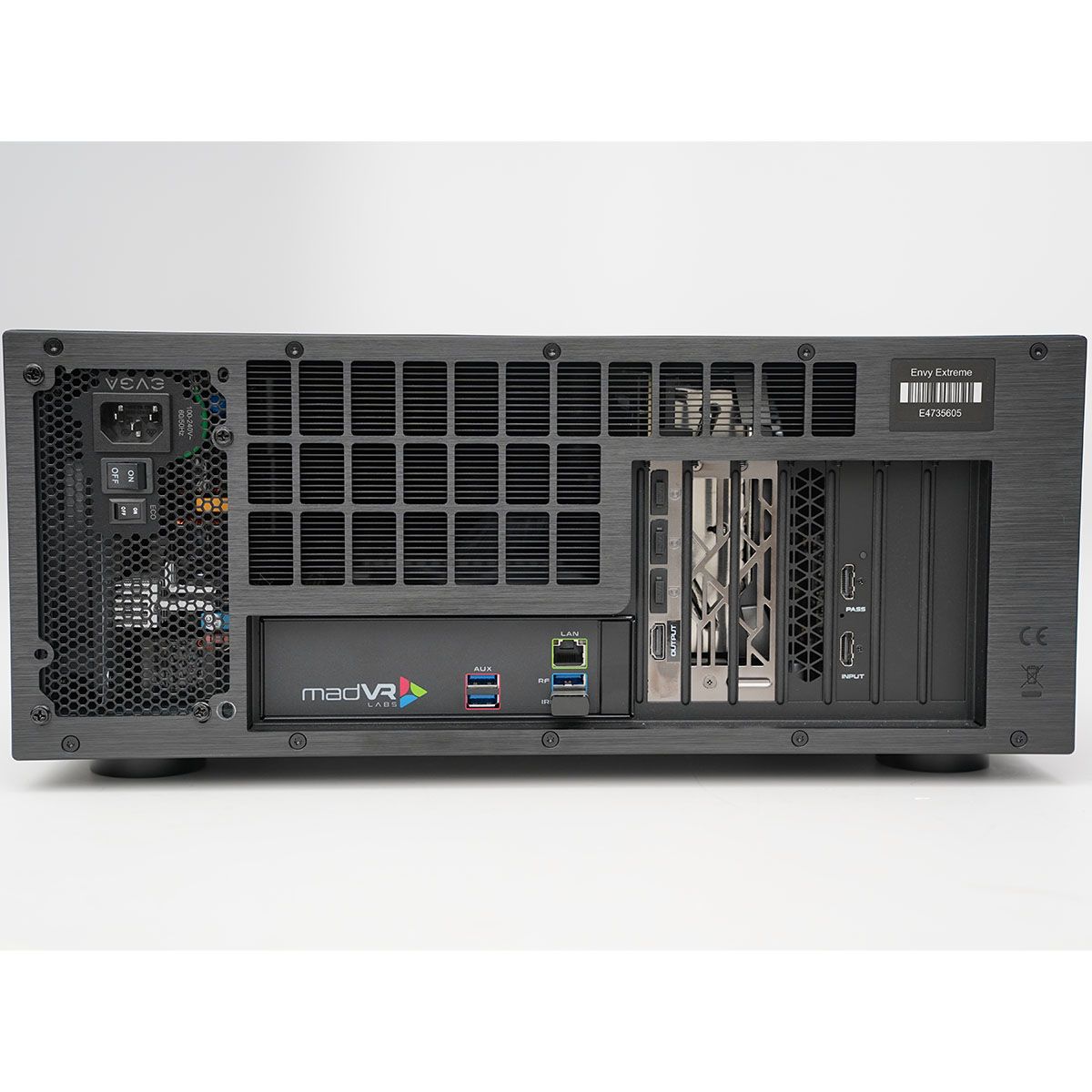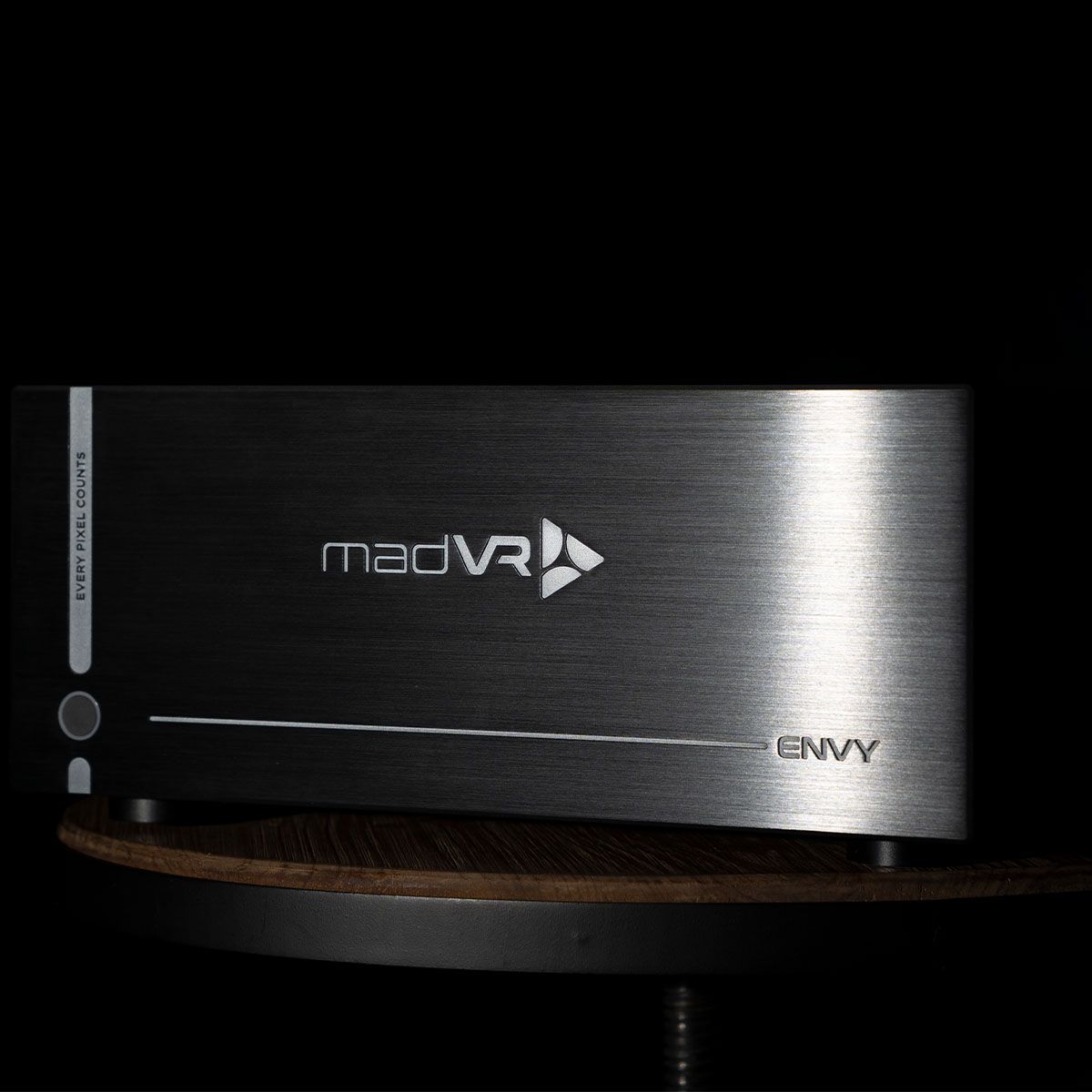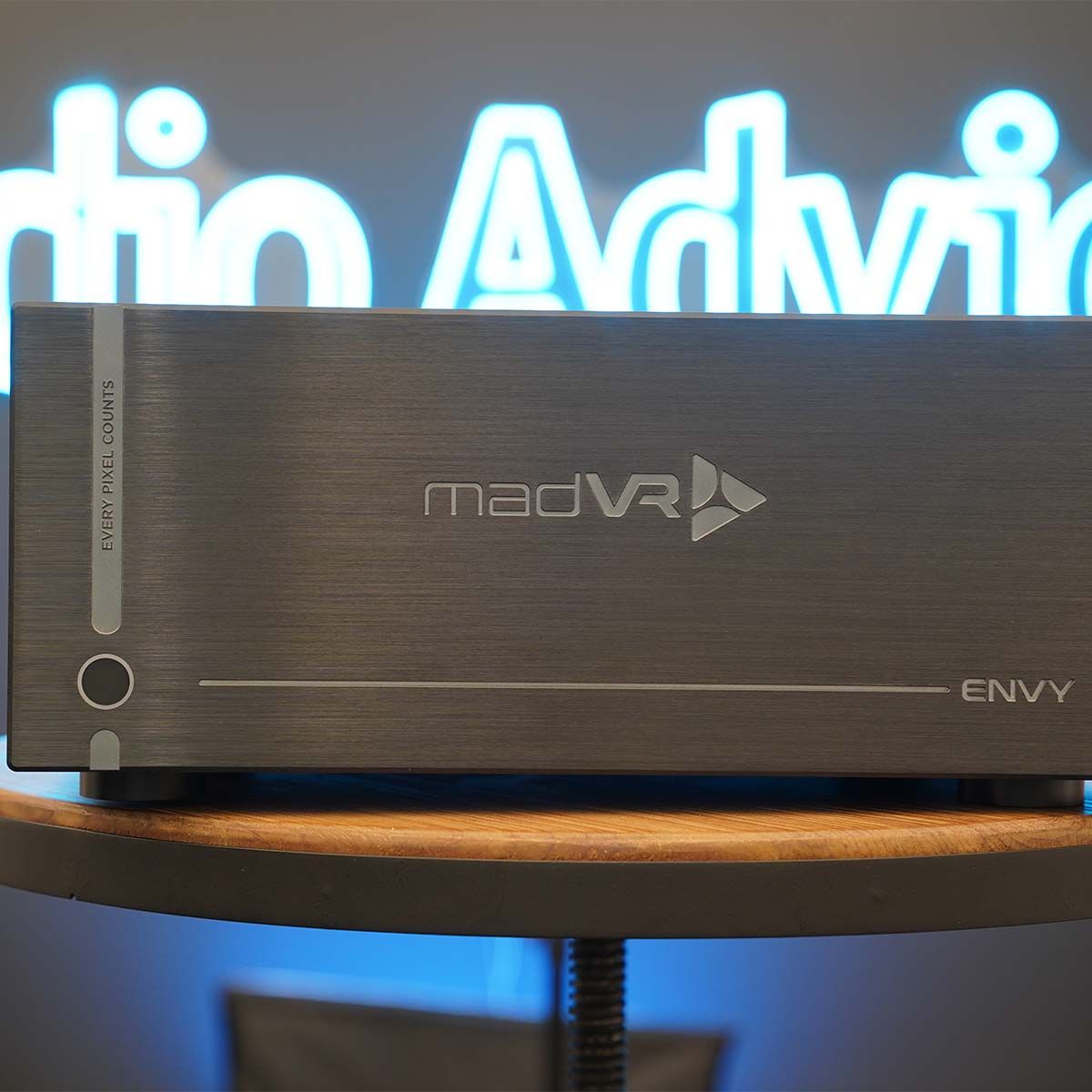madVR Envy Extreme
Video Processor w/ HDR Dynamic Tone Mapping, Instant Aspect Ration Tone Detection, 4K/5K/8K Upscaling & Sharpening, and Subtitle Management
Audio Advice is the only authorized seller of certified pre-owned madVR Envy Video Processors in the nation.
The award-winning madVR Envy uses patent-pending video processing to deliver the ultimate picture quality in your dedicated home theater. Enjoy the most dramatic yet highly accurate 4K HDR frame-by-frame dynamic tone mapping, unrivaled 4K upscaling, the fastest black bar & aspect ratio detection and zooming, debanding and compression artifact reduction, specialized sharpening and detail enhancement, 3D LUT calibration with unprecedented precision, and more.
High Notes
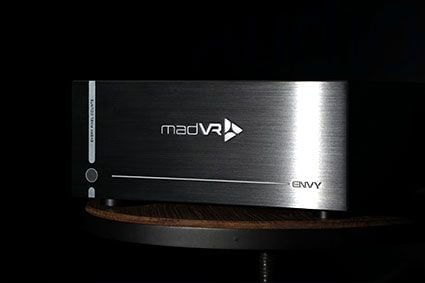
Industry Best Dynamic Tone Mapping
Anyone who has seen the way the Envy improves HDR content has been shocked. It is so far ahead of anything else, the difference you see is amazing. Blobs of light turn into individual LEDs, and ocean waves go from a white mass to individual water droplets. Envy uses its exclusive algorithms and massive processing power to be the best.
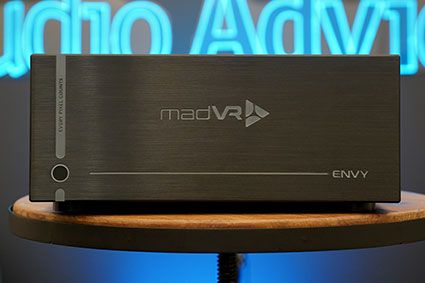
Automatic Aspect Ratio
If you have a widescreen projection system, you will love the way the Envy automatically adjusts instantly with aspect ratio changes.
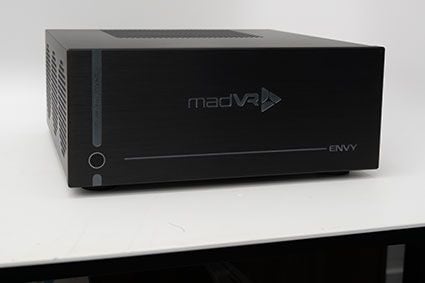
Incredible Setup Flexibility and Upgradability
Envy's self-help menu and unique profile system allow you to fine-tune yours to work best with each of our sources and pull up the config easily or even automatically with a control system.
What is the Envy?
The Envy is a powerful Video Processor, dedicated to providing the best possible picture quality for high-end Cinema. Modern video images exist in the digital domain, and so must go through a wide variety of devices and processors to get from the original source to the screen where it is viewed. Video Processors are present in the players we use, a/v receivers, pre-pros, as well as the projector or other display device. These will vary in what they are able to do with the image, and more importantly, how well they do it. The Envy was designed to outperform them all, so let’s take a look at how it measures up.
madVR History
Many in the audiovisual world will be familiar with madVR, as its software is well respected, and has been used in home theater personal computers (HTPC) for more than a decade. This required building and maintaining a relatively high-end computer to handle some heavy-duty processing, and typically demanded quite a bit of technical expertise to tap its full potential.
In 2019, Mathias Rauen, the technical genius behind madVR, teamed up with Richard Litofsky, an entrepreneur with 30 years of experience building technologically oriented companies, to create madVR Labs, LLC. The goal was to take the capabilities of a madVR HTPC and transform it into a readily available and easy to set up product, which could be used by anybody, in any cinema environment. The Envy is the result, and it has been available since 2020.
Introducing Envy MK2
The Envy has had 2 models: the first is the Envy Pro, which is the less expensive version with the vast majority of capabilities that most theaters need. The second is the more expensive Envy Extreme, which is a ‘no holds barred’ device, offering more processing power and overhead for future functionality upgrades. Interestingly enough, we have found that more customers are ultimately choosing the Extreme over the Pro for the long term extra processing power and overhead.
madVR Labs has just announced the Envy MK2. The Envy Extreme MK2 is powered by the Nvidia 4080 GPU, boosting processing power by as much as 100% over the 3080 used in the original Extreme (now designated MK1), while also offering exceptional benefits in cooling and efficiency. The Envy Pro MK2 will receive an upgraded GPU with triple-fan design for enhanced cooling efficiency and noise reduction.
One of the things that has really impressed us about MadVR is how much feedback they have sought to improve the product over time. They are constantly soliciting our feedback on functionality and software. They even started reviewing the designs of the new MK2 versions with us, nearly a year ago, to make sure they got maximum bang for the buck in the new hardware.
The results are that the new MK2 products will benefit from ECC-RAM, providing unparalleled reliability and stability, an upgraded motherboard, power supply, twice the RAM and SSD capacity as the MK1 models, along with the new Glacier X2 cooling system. This features three 140mm and two 120mm high-end static pressure fans, providing 50% more airflow. The net result is better performance and quieter operation, with noise now essentially inaudible from a couple of feet away when in Silent mode.
The increased GPU power found in the Extreme MK2 provides substantial headroom for the Envy to run more concurrent algorithms, and at higher strength levels, especially important in light of the GPU power demands of the new MotionAI motion interpolation technology, discussed below.
The Envy MK2, Extreme and Pro, features a brand new, custom engineered all-aluminum 3mm case (5mm in the rear) with a 20mm front plate. The case's seamless one-piece design for the lid and side walls creates a modern, high-end look. The MK2 also features a welcome reduction in size, from 5U to 4U, making it more space-efficient in racks and more versatile for use in spaces with poor ventilation. Custom made Rack Ears are now included with every Envy.
A brand new, redesigned Remote Control will be provided shortly after the MK2’s start shipping. It will be back-lit, which we find extremely useful in a dark theater environment, along with added buttons providing a higher degree of functionality.
Lastly, both Envy models now include a 5-year warranty, which we consider quite exceptional in the world of high-end audiovisual gear. This is a strong indication of madVR’s confidence in the overall quality of the new MK2 design. We would like to see other manufacturers offer similar protection!
madVR Envy MK2 Features
Dynamic Tone Mapping (DTM) for HDR Content
The latest and most exciting development in home theater is the production of shows and movies with 4k Resolution, High Dynamic Range (HDR) and Wide Color Gamut (WCG). This can create an unprecedented level of realism and visual impact when done right, but there are significant challenges to achieving this in our homes.
Specifically, most HDR mastering is based on having a very high degree of brightness available on the display device – 1,000 nits, or in some cases, up to 10,000 nits. The best current televisions can get between 600 and 1,000 nits, sometimes higher, while the average is about 450 nits. And when we look at projectors, with a reasonably large screen size, they're generally in the 50 to 150 nit range.
As a result, in order to display HDR in home theaters where the brightness is quite limited, the original signal must be “tone mapped” to the range that is actually available. Initial efforts used “static” tone mapping, where a single map was used for any and all HDR content, but it really didn’t work well.
The Envy is one of very few devices that uses “dynamic” tone mapping. Here, each and every frame is independently analyzed, and sophisticated algorithms are used to produce the best looking image. The Envy allows you to input the actual Nits available on your screen, which it then uses to customize its output for your particular theater.
This makes a huge difference, and it does a superb job of creating the visual impact made possible by HDR. Before adding the Envy to our system, we frequently encountered scenes that were either too dark, others too bright, or areas where whites were clipped or blacks were crushed. The Envy has beautifully handled everything we’ve thrown at it, and we’ve been able to just sit back and enjoy the show!
The most recent firmware provides 5 selectable “looks” to the dynamic tone mapping, which along with other options available, provides the ability to fully ‘tweak’ the image to look its best in your own theater.


Harry Potter scene with the Projector’s DTM

Harry Potter scene with the madVR Envy’s DTM
Aspect Ratio Management
The movies and shows we enjoy can vary quite a bit in their Aspect Ratio – from the HDTV standard of 16:9, to 2.00:1 often used by Netflix, all the way to 2.40:1 for most motion pictures. This makes things difficult for any display device, and very often the picture gets compromised as a result.
If you’re using a 16:9 screen, and watching a 2.40:1 movie, there are letterbox bars at the top and bottom, which can be visually distracting. The Envy provides an option to automatically move the entire image either up or down, eliminating one of those bars, which reduces this distraction.
Widescreen Explained: What’s with the Black Bars?
If you’re using a Scope Screen (where the Aspect Ratio is between 2.35:1 and 2.40:1), the Envy will automatically detect the incoming aspect ratio, and scale it so that it always fills the full height of your screen, and as much of the width as the aspect ratio allows. This is a huge benefit. Before adding the Envy, we would have to use different lens memory settings for each and every aspect ratio, which physically zooms the lens, shifts the image, and refocuses the picture. This usually takes at least 10-20 seconds, and because it relies on physical motors, the precision isn’t exact, and tends to drift over time, requiring additional manual adjustments. But with the Envy, it happens instantly and automatically, and is always precise.
This feature really comes in handy when watching movies where the aspect ratio changes during the same movie – Christopher Nolan’s movies in particular use this a lot. We watched Tenet, where the Aspect Ratio varied between 16:9 and 2.20:1, and these changes were automatically and instantly detected, so that the movie optimally fills the screen from start to finish.
And perhaps even more importantly, if you’re watching a 2.40:1 movie, zoomed to fill your screen’s width, and you hit the player’s Pause button, to fast forward, find a time-stamp, or to select a different scene to watch, those On Screen Display elements are typically in a 16:9 format. Without the Envy, these can’t be seen because they would ‘spill’ over onto the screen’s frame and the wall behind the screen. But with the Envy, they are instantly recognized, and the image is automatically rescaled so that all On Screen Display elements are always visible. This was needed basically every time we watched a movie, and was incredibly useful.
Non Linear Stretch
Whenever there is a difference between the aspect ratio of what is being watched, and that of the screen where it is being displayed, there will be black bars present. When watching 16:9 content on a 2.40:1 screen, there will be ‘pillarbox’ bars on the sides. When watching 2.40:1 content on a 16:9 screen, there will be ‘letterbox’ bars on the top and bottom. In both situations, there is unused screen space, and many want an option to fill their screen, regardless of the Aspect Ratio.
The Envy provides a very easy way to reduce or eliminate the black bars in either of these situations. It provides a well-designed graphical interface where you can make the adjustments, and see the results in real time. You can configure this for any aspect ratio you want, and the settings will be automatically applied.
The image can be partially cropped, which will increase the image size, and reduce the black bars, with no distortion of the content’s geometry. This can be combined with stretching of selected areas of the content, along with compression of other areas. The result is a larger, more immersive image, with no black bars or unused space on the screen.
This is a personal choice, however, as some people prefer not to alter the original image in any way. But we do like the fact that the Envy provides the choice to the theater owner, to display the picture according to their personal preferences.

Subtitles
We often find it helpful to turn on subtitles, and when watching 2.40:1 content on a 2.40:1 screen, they are often partially or completely cropped out, because they’re in the black bar area usually below the screen. The Envy provides the ability to fix this, and the result is that the subtitles can be completely seen within a narrow bar at the bottom, with no bars at the top or sides. This is a huge benefit, and it works quite well. And even better, it does this automatically, needing no button pushes!


What you see without the Envy’s Subtitle Management

What you now see after turning on the Envy’s Subtitle Management
Upscaling
If you’re watching regular HD content (1920x1080 pixels) with a 4k Projector (3840x2160 pixels), the image must be ‘upscaled’ to be viewed correctly. This can take place in the player, the AVR, pre-pro, or the projector. These devices can get the basic job done, but having limited processing power, the results are often not optimal.
The Envy has a huge amount of processing power available with its hardware, and along with its sophisticated proprietary algorithms to handle the upscaling, HD content often appears just as sharp and detailed as if it were 4k to begin with.
Image Enhancement
The Envy provides an array of settings to further improve the image. This includes options for sharpness, edge enhancement, reduction of grain, compression artifacts, and mosquito noise, as well as other tools. We find that adding just a little sharpening to upscaled HD material provides a significant improvement in image quality. And a little noise reduction makes watching older, grainier movies more enjoyable.

Anamorphic Stretch
Many people use Anamorphic Lenses to further improve image quality when using Scope Screens. Projectors typically have 2 Anamorphic Modes of processing available – one for 16:9 content, and the other for 2.40:1 content – with no ‘in-between’ options. This creates major problems for seeing full menus and other on screen Display elements, as well as subtitles, or when watching shows with aspect ratios other than 16:9 and 2.40:1.
The Envy is designed to handle these automatically and optimally, and it lives up to its claims. Regardless of the aspect ratio of what you watch, the Envy scales it automatically, and it looks great. It basically provides an unlimited number of anamorphic modes, which no projector could possibly duplicate.
Geometry Correction
An anamorphic lens is frequently used when viewing content on a scope screen. They increase the brightness and pixel density, providing a better picture. But they do also cause some unwanted changes to the image: either ‘barrel’ distortion, where the sides bow outward, or ‘pincushion’ distortion, where they bow inward.
The Envy Extreme model has the unique ability to fully correct and eliminate both of these types of distortion, providing a precise fit between the image and screen. We used this feature in one of our theaters, and it worked exactly as described, and was quite simple to actually do the correction.
3D LUT
The capability to have your system professionally calibrated, using software such as ColourSpace and Calman, is built into the Envy, supporting 256-point LUTs. This provides a powerful way to get the most accurate image possible in your Theater.
Operation
Setup
Given the Envy’s sophistication, with all the power and complexity ‘under the hood,’ the initial Setup is surprisingly quick and straightforward. Physical connection is simple – plug the HDMI cable from your AVR or Pre-Pro into the Envy’s Input, and the cable to your projector into its Output. A Quick Start Guide is provided to walk you through the basic settings, which only takes 5-10 minutes or so. The Envy’s default settings provide excellent results for most Theaters, so there’s no need for much technical knowledge to get up and running.
Menu System
The Envy Menu system has on-screen, context-sensitive help, which explains what any given setting does, to help you decide what choice is best for your theater. And even better, if questions arise, we, or even madVR staff themselves, can establish a remote connection to your Envy, and walk through the Settings, as if we are in the room with you and quickly fine-tune your setup.
While the basic setup and configuration is quick and easy, the Envy does provide a wealth of options for the user who prefers to ‘geek out’ and fully customize their setup in all the detail they want. One of the things we really liked was how easy it was to try out new settings without changing the defaults. We’ve used complex electronics in the past without this type of design, and have seen how difficult it can be to get back to where you started after making a variety of settings changes.
To accomplish this, it uses “Active”, “Temporary” and “Base” designation for all the Envy’s settings. When you start making changes, they are assigned as “Temporary,” so that once you’re done with that viewing session, all of these values will automatically reset to their default (or “Base”) values. And once you decide which settings you want to be ‘permanent’ this is easily done, by assigning that as the “Base” value with a simple button press. Honestly, most customers don’t even touch this stuff and let us handle it for them. But for those who are really into it, the Envy really makes customization easy.
Profiles
This is an ingenious concept developed by madVR where you can ‘group’ a collection of any settings available in the Envy, in a ‘Profile,’ to be used together whenever you want. For example, we found we wanted different Envy settings to be used depending on whether we were watching with a Roku vs a Blu-ray Player. With the Roku, we wanted certain Subtitle settings to be used, which were different when watching with our Blu-ray Player. We were able to use the Envy’s built-in ‘source’ profiles, and assign whatever setting we wanted to be used whenever that profile was activated.
If you want to use the Envy with different Displays (e.g. a TV as well as a Projector), you can take advantage of its Display Profiles to configure optimal settings for each device.
You can also create Custom Profiles of your choosing, limited only by your imagination in putting these to use. For example, when evaluating the different DTM “Looks” we created profiles for these to provide instant access, which made comparisons much easier to do.
madVR has provided an Introduction to Profiles, and a Profiles User Guide to help you understand how profiles work. But honestly, this is harder to explain in words than it is to use in practice. Once the profile concept ‘clicked’ in our minds, we saw how powerful it was, how easily it could be implemented, and how we could quickly configure the Envy to use optimal settings for any situation. The more and more we have implemented the better we’ve got at setting these up for clients where they don’t even need to understand the details–we just make it work in the background for them.

Control
The Envy comes with its own Remote, which can be configured to use either IR or RF. One of our few pet peeves with the original Envy was that the remote was not backlit. So power users that will make more frequent use of the remote will soon be able to enjoy its sleek design, great feel in the hand, and additional buttons to program and use, in addition to it being backlit.
madVR has released drivers to allow integration with a variety of automation systems, including Control4, Crestron, Savant and RTI, which can further enhance the Envy’s ease of use. We have used the Control4 driver in many theaters, and have found it to be well thought out, and easy to program. As an example, we combined Control4 Automation with the Envy’s Profile System, so that whether we used the Roku or Blu-ray Player, the correct Envy Profile was automatically activated.
But our favorite use was with the vertical masking for our scope screen. Control4 gets the Aspect Ratio from the Envy, and then sends a command to the masking system to move the correct position for whatever we were watching. We were pretty impressed with how well this worked!
Firmware Updates
As anyone who has had to deal with Firmware updates for any electronic device can attest, while great in concept, they can provide a mixed experience. For one thing, the update process itself can be cumbersome, often requiring a download to a USB stick, plugging it into the device and then hoping it is recognized. Or sometimes specialized cables are needed to establish a connection. And once updated, it’s not unusual to have some things work better, while other features get broken, making us regret having done the update.
The Envy avoids all of these problems. The update process itself uses the Envy’s ethernet connection and takes less than 30 seconds to complete. But more importantly, if for whatever reason you want to revert to a previous Firmware version, this can easily be done in those same 30 seconds. Successfully reverting to an older Firmware is almost unheard of in this type of device, and is a feature we would like to see used in more electronic devices.

Latest Envy Developments
MotionAI™
The newest feature to be added is called MotionAITM , addressing one of the common complaints in the world of cinema. Most movies are filmed at 24 fps, and when viewed, there is often some ‘jerkiness’ or ‘judder’ seen, especially when the camera is panning. This can be distracting, and even fatiguing on the eyes. Using its AI-based algorithms, the Envy now allows 24fps content to be seen with markedly improved smoothness, along with greater sharpness and detail.
We have been alpha-testing this new feature, and we have been incredibly impressed by the improvements it provides in both motion smoothing, and sharpness during camera pans. And equally important, it does this without producing the ‘soap opera effect’ that so many film lovers dislike.
They are still working out some bugs (for example, occasionally seeing artifacts during a transition from one scene or camera cut to another), but we’re confident these will soon be resolved.
We think MotionAI will set a new bar for motion handling in the industry, and look forward to its public release in the near future.
Roadmap for the Future
With the introduction of the Envy Extreme MK2, there is a tremendous increase in computation power available. This paves the way for future, industry-first AI-based algorithms with the roadmap including:
- AI-based Dynamic Tone Mapping (DTM gen3)
- Motion compensated multi-frame noise reduction
- Motion compensated multiframe super resolution (upscaling)
- Motion compensated multi-frame deinterlacing
- NGU Upscaling 2.0
- Luma guided AI chroma upscaling, and more.
Conclusions
We have been very impressed with the performance of the Envy in all of the theaters we have done. It provides not only superb picture quality, but improves the ease of use dramatically. This can be very important when family members want to watch something on their own!
Obviously we are extremely impressed with the MadVR Envy - so what’s not to like about it? Well first, neither of these models are inexpensive. If you have budget for a MadVR Envy we think it is a great add to virtually any theater setup. However, it is going to be out of budget for some. The good news is that with the launch of the new MK2 hardware, we expect many owners of the original MK1 Envys will upgrade, thus providing the ability for those on a tighter budget to still get an Envy through the previously owned program.
Second, the incredible processing it performs takes time. The Envy adds about 200 milliseconds of delay in the video signal. This means that you will need to add audio delay in your audio receiver or processor. Fortunately, this is not very hard. We have produced a YouTube video that our team and DIY customers use to nail lip sync delay.
How To Perfectly Set Lip Sync Calibration In Your Home Theater
What this also means is that if you are a hardcore gamer, you will most likely not want to use the Envy for gaming. Since we are based in Raleigh, the home of Epic Games, we have implemented incredible theaters for many hardcore gamers. In these cases, we simply run an extra HDMI cable to the projector using either the passthrough output on the Envy, or a second video output on your processor. We then just program the system to use one input on the projector for gaming and the other for everything else.
As one of the largest MadVR dealers in the world, we’ve seen pretty much every permutation of projectors, receivers and room setup. Even our customers who have vacation homes in remote locations have been able to easily plug in their new Envys and have us remotely set them up for them. Every single customer so far has raved about it which to us is the ultimate sign of success.
Our madVR experts at Audio Advice would be happy to answer detailed questions for you. Our team just loves this type of high performance product and enjoys helping people find the right solutions for their home theaters.
At Audio Advice, we've been designing and installing high-performance home theaters & smart home systems for our customers in North Carolina and the surrounding areas for decades. In fact, we've delivered more custom theaters than anyone in the Southeast! We are now offering Home Theater Design no matter where you live in the United States! If you are interested in a custom home theater or upgrading your current system, give us a call at 888.899.8776, chat with us , or stop by our award-winning showrooms. We can't wait to help you build your ultimate home theater!
HDR DYNAMIC TONE MAPPING
madVR Labs pioneered dynamic frame-by-frame HDR Dynamic Tone Mapping. Their patent-pending DTM 2.0 engine analyzes every frame in real-time to optimize every single pixel. That’s nearly a half billion pixels per second at 4K60! Their proprietary Highlight Recovery, Contrast Recovery, and Shadow Detail Recovery provide an image so stunning you will be addicted at first sight. Finally, you can enjoy HDR movies and shows at home like never before possible, just as the director intended. Now with fully customizable “Looks”!
AUTO ASPECT RATIO CONTROL
Envy detects every single aspect ratio and instantly adjusts the image to exactly fit your screen, regardless of its AR and the AR of the movie even as it changes back and forth. This is sorely needed for screens with wide aspect ratios and benefits those with 16:9 screens. Envy even watches the movie along with you, to learn the aspect ratios in use and ensure it delivers unrivaled auto AR control to rid you of those pesky black bars once and for all.
4K UPSCALING & SHARPENING
Envy uses proprietary machine learning algorithms to provide unrivaled 4K and 8K upscaling and anamorphic stretch. It also provides the highest quality chroma upscaling (4:2:0->4:4:4) and can automatically reverse certain damaging chroma upscaling used by source players to then perfectly apply its superior chroma upscaling.
3D LUT CALIBRATION
Envy enables incredibly accurate calibrations by supporting massive 256-point LUTs, without any loss of measurement data and precision, unlike with other processors. This translates to 16.7 million points of accuracy, compared to less than 5,000 points with others. Envy integrates with calibration products including ColourSpace, Calman, displayCal, and more.
IMAGE ENHANCEMENTS
Envy provides the highest quality algorithms to remove compression artifacts and mosquito noise, as well as de-banding to remove 8-bit banding artifacts. Many other favorite tweaks for image enhancements are also available to remove or add grain, sharpen edges, remove ringing, and more.
SUBTITLE HANDLING & PROFILING
Tired of cutoff subtitles with your scoped screen? madVR's subtitle handing dynamically resizes your image to fit subtitles only when needed, maximizing your picture size. And their new profile system provides the most powerful yet easy to use settings management you’ve ever seen in any product before it.
8K AND HDMI 2.1 SUPPORT
The Envy Extreme supports 8K and HDMI 2.1 output, and the Pro will receive a paid upgrade in 2021 to HDMI 2.1 as well. This provides full 48 Gbps HDMI 2.1 HDCP 2.3 support, making it the first and only stand-alone video processor to offer these advanced capabilities. madVR's modern-day hardware platform ensures you’ll enjoy the Envy for many years to come.
CONTINUOUS INNOVATION
Updates to Envy can be installed in less than 60 seconds with just the click of your remote. For example, madVR will introduce the world’s first machine learning based motion interpolation for the best motion handling yet, along with geometry control to support a wide range of installations, eliminate barrel distortion and artifacts from anamorphic lenses or curved screens.
SIMPLE TO INSTALL AND USE
Set up is so simple that it takes just five minutes. No experience is required. Just plug the HDMI output from your AVR into the Envy, and send the Envy’s HDMI output to your display.
madVR Envy Series - Model Comparison
| Features by Model | Pro MK2 | Extreme MK2 | Extreme 3080 | Extreme 2080 |
|---|---|---|---|---|
| HDR Dynamic Tone Mapping (DTM) | ||||
| Frame by frame DTM, no metadata required | ✔ | ✔ | ✔ | ✔ |
| Advanced dual-algorithm scene change detection | ✔ | ✔ | ✔ | ✔ |
| Contrast Recovery (off, low, medium, high) | All | All | All | All |
| Shadow Detail Recovery (off, low, medium, high, very high, insane) | All except "insane" | All | All | All |
| Highlight Recovery up to 4K24 (off, low, medium, high, very high, insane) | All except "insane" | All | All | All |
| Highlight Recovery at 4K60 (off, low, medium, high, very high, insane) | - | All | All | All |
| DTM with 1080p60 HDR | ★★★★★ | ★★★★★ | ★★★★★ | ★★★★★ |
| DTM with 4K24 HDR | ★★★★★ | ★★★★★ | ★★★★★ | ★★★★★ |
| DTM with 4K60 HDR | ★★★★☆ | ★★★★★ | ★★★★★ | ★★★★★ |
| Scaling | ||||
| AI-based ring-free & artifact-free chroma upscaling | ✔ | ✔ | ✔ | ✔ |
| AI-based ring-free & artifact-free image upscaling | ✔ | ✔ | ✔ | ✔ |
| Upscaling can be switched to either optimize high or low quality sources | ✔ | ✔ | ✔ | ✔ |
| Upscaling to 4K24 | ★★★★★ | ★★★★★ | ★★★★★ | ★★★★★ |
| Upscaling to 4K60 | ★★★★☆ | ★★★★★ | ★★★★★ | ★★★★★ |
| Upscaling to 5K24 and 8K24 | - | ★★★★★ | ★★★★★ | - |
| Upscaling to 5K50/60, and any custom resolution up to 8K60 | - | ★★★★★ | ★★★★★ | - |
| Sharp & ring-free high quality downscaling | ★★★★★ | ★★★★★ | ★★★★★ | ★★★★★ |
| Aspect Ratios & Front Projection | ||||
| Automatic, truly instant aspect ratio and black bar detection, including IMAX format | ✔ | ✔ | ✔ | ✔ |
| Subtitle Management (dynamically fit subtitles while maximizing image size) | ✔ | ✔ | ✔ | ✔ |
| Masking for projection screens | ✔ | ✔ | ✔ | ✔ |
| Image shift for CIW projection | ✔ | ✔ | ✔ | ✔ |
| Advanced convergence correction | ✔ | ✔ | ✔ | ✔ |
| Non-linear Stretch (NLS+) fits any aspect ratio content to any aspect ratio screen | ✔ | ✔ | ✔ | ✔ |
| Advanced geometry correction (fix a-lens barrel distortion, fit curved screens, off-axis PJ installs) | - | ✔ | ✔ | ✔ |
| AI-based anamorphic stretch upscaling for 1080p projectors | ★★★★★ | ★★★★★ | ★★★★★ | ★★★★★ |
| AI-based anamorphic stretch upscaling for 4K projectors | ★★★★☆ | ★★★★★ | ★★★★★ | ★★★★★ |
| AI-based anamorphic stretch upscaling for 5K/8K projectors | - | ★★★★★ | ★★★★★ | - |
| Artifact Reduction and Edge/Texture Enhancement | ||||
| AI-based algorithm to reduce compression artifacts | ★★★★☆ | ★★★★★ | ★★★★★ | ★★★★★ |
| Algorithm to reduce banding artifacts | ★★★★★ | ★★★★★ | ★★★★★ | ★★★★★ |
| Edge enhancement (aka sharpening) | ★★★★★ | ★★★★★ | ★★★★★ | ★★★★★ |
| Texture detail enhancement | ★★★★★ | ★★★★★ | ★★★★★ | ★★★★★ |
| Product Roadmap - Future Algorithms | ||||
| MotionAITM (per-pixel, AI based motion interpolation, currently in private beta) | - | ★★★★★ | ★★★★★ | ★★★★☆ |
| AI-based motion compensated video deinterlacing | - | ★★★★★ | ★★★★★ | Unconfirmed |
| AI-based motion compensated multi frame noise/grain reduction | - | ★★★★★ | ★★★★★ | Unconfirmed |
| AI-based grain agnostic sharpening | - | ★★★★★ | ★★★★★ | Unconfirmed |
| AI-based 4K HDR dynamic tone mapping processing (DTM gen3) | - | ★★★★★ | ★★★★★ | Unconfirmed |
| Additional undisclosed AI-based algorithms and features | - | ★★★★★ | ★★★★★ | Unconfirmed |
| General | ||||
| 96bit per pixel floating point using 4:4:4 for all algorithms | ★★★★★ | ★★★★★ | ★★★★★ | ★★★★★ |
| Extreme quality dithering algorithm | ★★★★★ | ★★★★★ | ★★★★★ | ★★★★★ |
| Smooth motion algorithm for displays with no (or poor) 24 FPS support | ★★★★★ | ★★★★★ | ★★★★★ | ★★★★★ |
| Automatic optimization of algorithm quality levels | ✔ | ✔ | ✔ | ✔ |
| Advanced 3D LUT calibration | ✔ | ✔ | ✔ | ✔ |
| Massive 3D and 1D LUTs (3D LUT 65^3 or 256^3, 1D front/back LUTs 4,096 points, 12 bit precision) | ✔ | ✔ | ✔ | ✔ |
| Software updates easily installable via Envy menu | ✔ | ✔ | ✔ | ✔ |
| Remote technical assistance from authorized dealers ("madAssist") | ✔ | ✔ | ✔ | ✔ |
| Highly intuitive user interface, true plug-and-play installation in minutes | ✔ | ✔ | ✔ | ✔ |
| IP control (Crestron, Control4, Savant, RTI, others) | ✔ | ✔ | ✔ | ✔ |
| Frame packed 1080p24 3D support | ✔ | ✔ | ✔ | ✔ |
| Remote control included | Dual band IR + RF | Dual band IR + RF | Dual band IR + RF | Dual band IR + RF |
| Supported max input formats | 60 Hz: 4096x2160 in 12 bit 4:2:0, 4:2:2 or 8 bit 4:4:4, RGB 30 Hz: 4096x2160 in 12 bit 4:2:0, 4:2:2 or 12 bit 4:4:4, RGB |
60 Hz: 4096x2160 in 12 bit 4:2:0, 4:2:2 or 8 bit 4:4:4, RGB 30 Hz: 4096x2160 in 12 bit 4:2:0, 4:2:2 or 12 bit 4:4:4, RGB |
60 Hz: 4096x2160 in 12 bit 4:2:0, 4:2:2 or 8 bit 4:4:4, RGB 30 Hz: 4096x2160 in 12 bit 4:2:0, 4:2:2 or 12 bit 4:4:4, RGB |
60 Hz: 4096x2160 in 12 bit 4:2:0, 4:2:2 or 8 bit 4:4:4, RGB 30 Hz: 4096x2160 in 12 bit 4:2:0, 4:2:2 or 12 bit 4:4:4, RGB |
| Supported max output resolutions | All up to 4K60 | All up to 4K120 and 8K60 | All up to 4K120 and 8K60 | All up to 4K60 |
| Hardware and Miscellaneous | ||||
| Warranty on parts and labor | 5 Years | 5 Years | 2 Years | 2 Years |
| General CPU processing power (cores / threads) | 6 /12 | 6 /12 | 6 /12 | Not Available |
| General graphics processing power (GFLOPS) | 9,500 | 43,000 | 25,000 | Not Available |
| Specialized AI graphics processing power (Tensor core GFLOPS) | 37,500 | 172,000 - 344,000 | 200,000 | Not Available |
| Quality when running multiple demanding algorithms simultaneously | ★★★☆☆ | ★★★★★ | ★★★★★ | ★★★☆☆ |
| HDMI 2.0b HDCP 2.2 18.0 Gbps input ports | 1 | 1 | 1 | 1 |
| HDMI 2.1 HDCP 2.3 48.0 Gbps output ports | 1 | 1 | 1 | - |
| HDMI 2.0b HDCP 2.2 18.0 Gbps zero-latency pass-thru | 1 | 1 | 1 | 1 |
| Paid options for future hardware updates | - | ✔ | - | - |
| Power consumption | 60W - 205W | 60W - 400W | 60W - 350W | 60W - 350W |
| AC power input | 110V - 240V | 110V - 240V | 110V - 240V | 110V - 240V |
| AC power frequency | 50Hz - 60Hz | 50Hz - 60Hz | 50Hz - 60Hz | 50Hz - 60Hz |
| Dimensions and Weight | ||||
| Shipping weight | 46 lbs (20.9.6 Kg) | 48 lbs (21.8 Kg) | 31 lbs (14.1 Kg) | 31 lbs (14.1 Kg) |
| Rack mount ears and screws included | ✔ | ✔ | - | - |
| Rack units | 4U | 4U | 5U | 5U |
| Unit dimensions with feet (W x D x H) | 17.31 x 17.44 x 7.56" | 17.31 x 17.44 x 7.56" | 17.32 x 17.13 x 6.89" | 17.32 x 17.13 x 6.89" |
| Shipping dimensions (W x D x H) | 27 x 24 x 14" | 27 x 24 x 14" | 22 x 23 x 13" | 22 x 23 x 13" |

